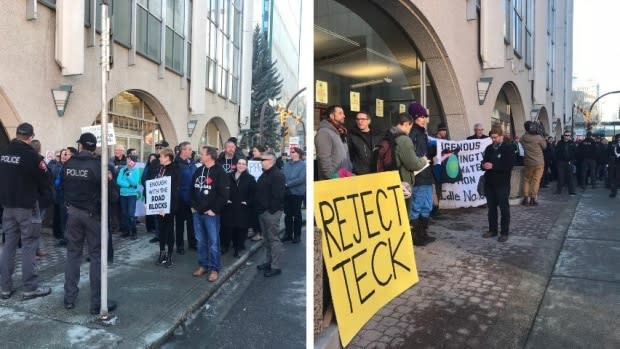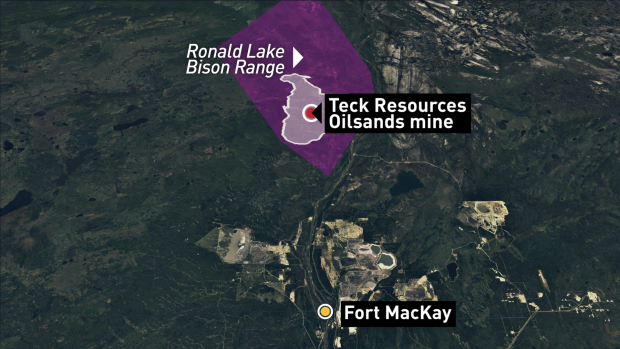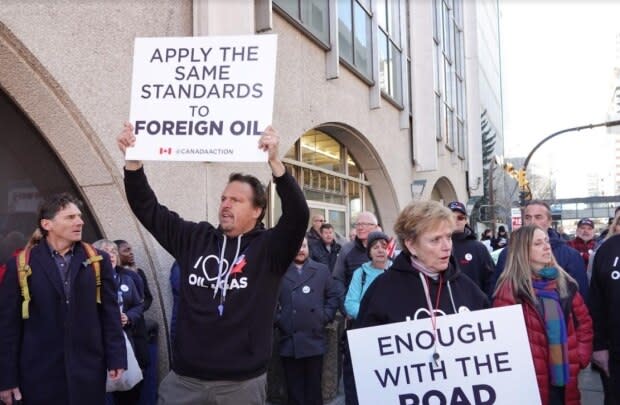Duelling demonstrations held for and against Teck's $20B Frontier oilsands mine
Duelling rallies held up traffic Wednesday on Ninth Avenue in downtown Calgary as opponents of a proposed oilsands mine faced off with demonstrators who came out to show their support for the $20-billion project.
A few dozen activists with Extinction Rebellion stood outside the office building where Teck Resources has an office. They displayed signs calling for Ottawa to reject the company's bid to build the Frontier mine north of Fort McMurray, Alta., which would produce 260,000 barrels of oil a day.
"Just reading the news and headlines that are available to me as a layperson, there are some economic issues, there are Indigenous rights issues, there are environmental issues, habitat issues, and then of course the big one being greenhouse gas emissions, climate emissions," said Extinction Rebellion member Sarah Flynn.
"Ultimately, this mine will be so devastating to the climate, and we're in a climate crisis … so the short-term advantages of the jobs and the income that this mine will offer will be far outweighed by the climate devastation that the whole world will experience."
At the same time, a counter-rally organized by Canada Action drew a greater number of people, who came out to voice support for the project.
On its Facebook page, the pro-resource sector group said the mine has the potential to boost government coffers by $70 billion over its lifespan and provide thousands of jobs.

Canada Action reminded its supporters that its event was intended to be non-partisan, positive and respectful.
As members of Extinction Rebellion made speeches opposing the project, some protesters with the other side chanted slogans such as "approve that mine" and "let us build." That prompted counter-slogans shouted back by the other group.
A supporter of Canada Action said oil from Canada's energy industry is more ethically produced and cleaner than that which comes from the Middle East, for example.
"If we don't put Canadian energy out, such as Teck mines, it will be replaced with foreign oil, such as Saudi Arabia, Argentina, other countries that do not live up to the same standards that we have here," said Josh Metz.
Metz said he thinks the opposing sides need to meet in the middle, acknowledge climate change is real, and take measured steps toward cleaner and renewable energy.

"But we've got to have a real conversation on how we get there," he said.
Teck has projected the open-pit mining operation, covering 292 square kilometres, will emit 4.1 megatonnes of carbon dioxide a year over its four decades in operation. But some environmental groups say that estimate is too low.
Frontier got the green light from regulators in July 2019 after a joint panel of officials from both the Alberta Energy Regulator and the Canadian Environmental Assessment Agency recommended the project receive the final approval from the federal environment minister.
The panel concluded that, even if Frontier is built, Alberta would be able to keep emissions from the sector below the 100 megatonnes cap for greenhouse gas emissions that the former provincial NDP government imposed on the industry.
Ottawa must make a decision on the project by the end of February under the Environmental Assessment Act.

Alberta Premier Jason Kenney has called for swift approval of the project, warning that rejection would send a signal that Canada's oil-and-gas sector has no future.
Environment Minister Jonathan Wilkinson says Ottawa must assess how Frontier fits into the government's promise to achieve net-zero emissions by 2050.
Teck Resources Ltd. says it has spent more than a decade on community engagement, including signing agreements with all 14 Indigenous communities in the project area.
The agreements set out a framework for co-operation in areas like environmental stewardship and economic opportunities, it says.
About 7,000 jobs would be created in building the mine and 2,500 workers would be needed to operate it.

